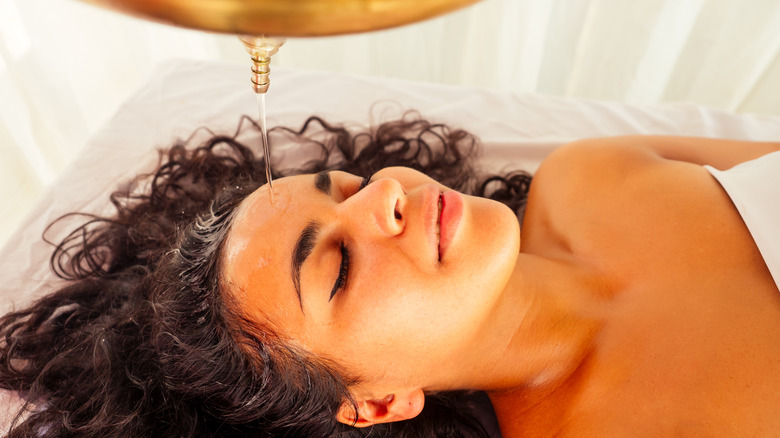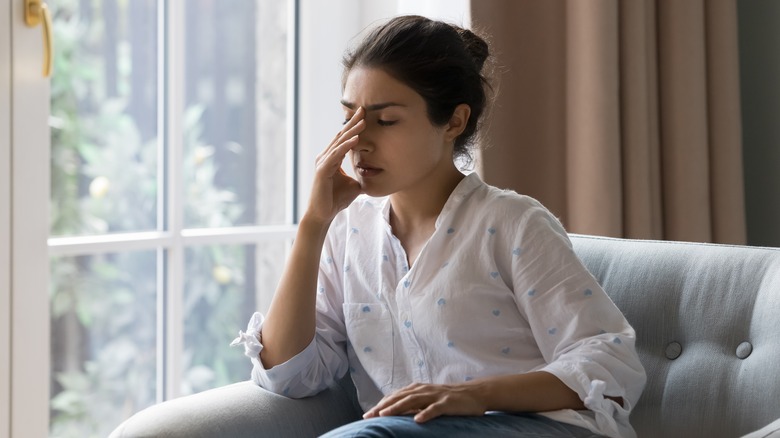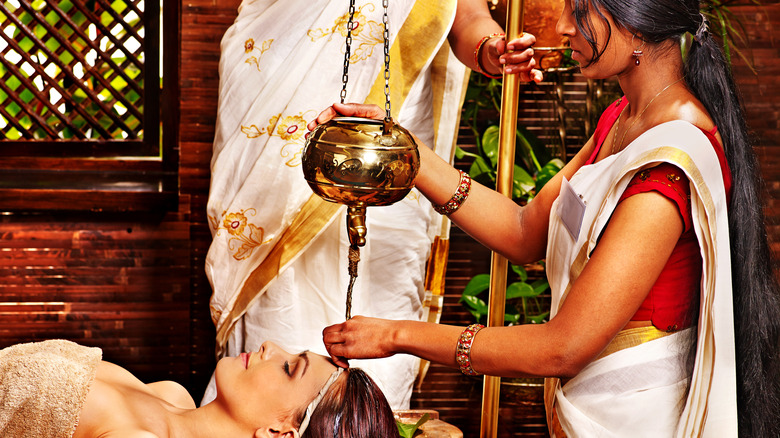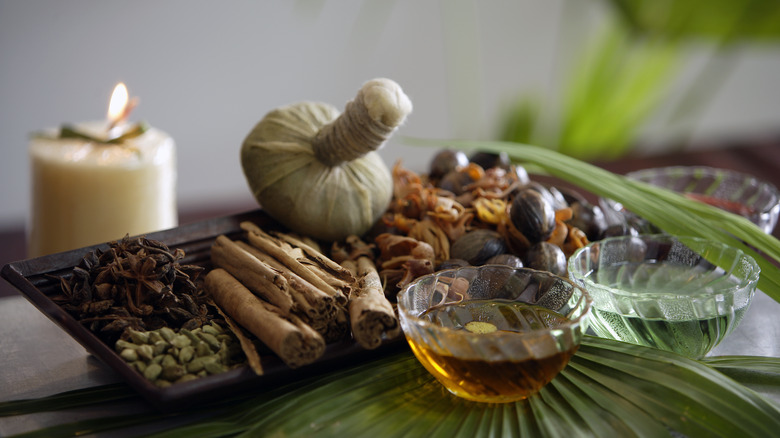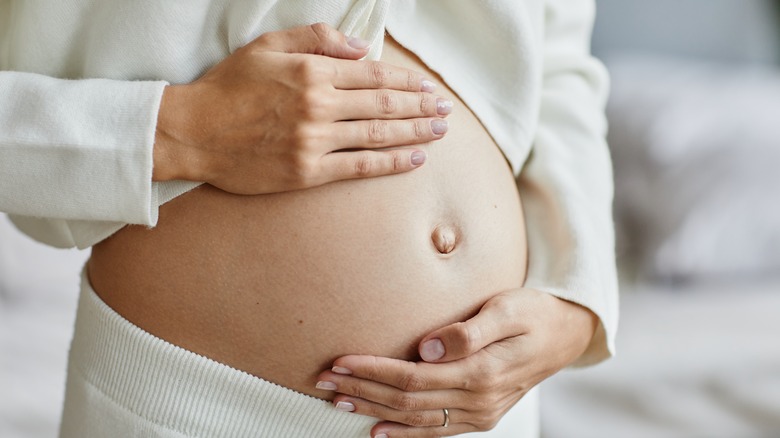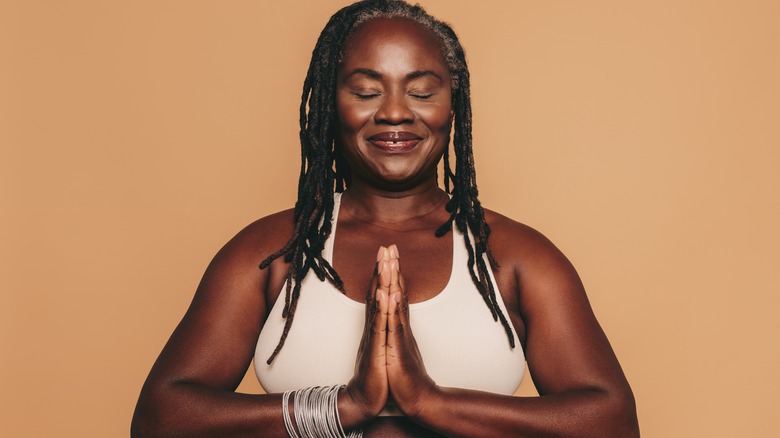Panchakarma: What To Know About The Intense, Celebrity-Favorite Cleanse
Celebrities make a lot of things trendy, but those ideas and practices have to come from somewhere. They often "discover" and popularize ancient practices encouraging spiritual or physical well-being (remember when Hollywood seemed obsessed with Kabbalah?). However new these practices seem, they've typically been around for millennia. The latest such thing is panchakarma, which was developed as part of Ayurveda, a 5,000-year-old South Asian system of healing both mind and body. It is based on the idea that every person is made up of a combination of the elements: earth, ether, water, fire, and air.
Panchakarma, for its part, is billed as a system of treatments that rejuvenate and cleanse the mind, body, and consciousness. In lay people's terms, it's a cleanse combined with oil treatments, massages, and other similar treatments that'll help you even out your mind-body balance. Celebrities like Gwyneth Paltrow, Busy Philipps, and Kourtney Kardashian have all gone on record touting the benefits of panchakarma, and even athletes like Aaron Rodgers favor the practice. However, although many aspects of the cleanse are enjoyable, it can also get pretty intense. A regular day at the spa, panchakarma is not.
This is why people turn to panchakarma
Most people seek panchakarma treatment because of some particular problem, like those who are always tired or suffering from digestive issues. So each session is tailored to hopefully correct their specific problems and address any imbalances in the five elements. This all translates into what is known as the Ayurvedic Tridosha, in which each of the elements makes up three doshas or energy types. These are Pitta, which is fire and water; Kapha, water and earth; and Vata, which is air and space. If the person's dosha balance is out of whack, it can cause problems like a disease.
Before beginning the steps requiring professional oversight, people undergoing panchakarma conduct their own home-based tasks. In the week or so prior to heading to see the licensed professionals at an Ayurveda spa, people are advised to follow a strict diet. This includes staying away from caffeine, alcohol, drugs, dairy products, white sugar, cold drinks, and food. This cleanse readies the body for the treatments, thus the reset. They're also advised to avoid heavy exercise, sex, television, parties, and loud music as they're seen as overly stimulating.
How the body is prepped for purification
A couple of procedures have to happen to get the body ready to detoxify. Ideally, the subject will undergo professionally administered svedana and snehan, which helps to ripen the doshas, says The Ayurvedic Institute. Snehan is well-known and can be best described as an oil massage. The technician will use full-body oil and a honed technique designed to relax the muscles, relieve stress, and get toxins into the gastrointestinal tract.
Right after each snehan, the subject is exposed to svedana or sweat therapy. The idea here is to use steam to make toxins less able to hold on. The steam also typically includes herbal infusions. When done with snehan, svedana hydrates the skin and expels toxins thanks to the sweat-oil combination. Svedana is also said to aid digestion and circulation, relax the muscles, reduce swelling, and have other benefits. However, if done excessively, it can cause irritability, dizziness, or fainting. So, as with anything health-related, proceed with caution and only under the supervision of a licensed professional.
Here's how panchakarma has changed over time
Western medicine has evolved quite a lot, even in only the last 100 years. So it only makes sense that panchakarma has done the same. This is exacerbated by the fact that practices differ depending on the region of India they hail from.
Traditional, ancient panchakarma included some pretty unappetizing stuff by modern standards. According to Chopra, some procedures included therapeutic vomiting, bloodletting, purgation, nasal irrigation, and even oil enemas. Instead, modern panchakarma employs some gentler (and generally blood-free) treatments. As already mentioned, this can include oil massages, steam treatments, mild laxatives, nasal attention, cleansing enemas, and general dietary guidelines. Such cleansing methods are known as shodanas and include a variety of practices. For example, Nasya, or nasal administration of medication, aims to clear out the imbalance of excessive bodily products like phlegm, bile, and blood, says The Ayurvedic Institute. This relieves the suffering caused by migraines, eye and ear problems, sinus congestion, and other breathing issues. The process can include a couple of different techniques, such as nasal massage or the insertion of medicine into the nose.
People who should and should not do panchakarma
Per Chopra, when the body gets out of balance, it leads to weak agni, which refers to metabolism, enzymes, and other critical bodily functions. This can lead to a buildup of poorly metabolized bodily substances, which is known as ama. Seen as toxic in nature, ama keeps the body from doing its various health-related jobs properly, causing a person to feel sluggish and generally bad. Anyone who experiences body pains and aches, gastrointestinal upset like constipation or diarrhea, fatigue, bad breath, gas, brain fog, and-or excessive cravings for food and drink is considered a prime candidate for panchakarma.
On the flip side, certain people should not do panchakarma, even when overseen by a licensed professional. For example, pregnant women should not partake due to dietary restrictions, steam baths, etc. Other women should plan around their monthly cycle to avoid overlap. Because panchakarma can sometimes be intense, people must be strong enough to handle it. This is why reputable facilities will insist on a consultation to ensure the client is up to the cleanse challenge.
True panchakarma continues well after the cleanse
The physical and spiritual reset that panchakarma offers will only last so long. Practitioners typically give patients a laundry list of practices to maintain at home because it's seen more as a way of life than something you do when you start to feel lousy. Following the spa portion's completion, great practitioners will give recommendations on daily maintenance tailored to the individual's needs. This can include yoga, meditation, self-massage, and so on.
It's also commonplace for people to follow daily dietary suggestions to keep the bodily humors in better balance than before. These practices are also known to relieve stress and tension, which often throws the body out of whack in the first place. To maximize the effects of panchakarma, however, resist the urge to indulge in greasy, processed food and alcohol the moment it's complete. Instead, gently return to somewhat normal daily practices while being more mindful of choices to stay healthier and happier for the long term.
